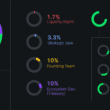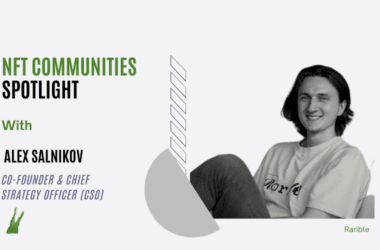Launched less than two years ago, video-sharing mobile app Chingari has seen rapid growth thanks to India’s ban on TikTok. With over 35 million monthly active users, the app dominates the vernacular market serving a large part of tier two, three and four cities in India.
Last month, Chingari closed a $15 million funding round as it ramps up its NFT efforts, and has recently integrated its native GARI token as an in-app currency and governance token which will empower the token holders to decide the future development of the platform.
As other creator-led video platforms have yet to enter the NFT space the way Chingari has, Chingari is confident that it will be the world’s biggest video NFT marketplace, especially with its first-mover advantage.
With expansion and new features in the pipeline for the app, we get Sumit Ghosh, co-founder and CEO of Chingari, to tell us more about the platform’s NFT marketplace and the utility of the app’s native token, GARI.
Please tell us about yourself and the story behind Chingari.
I am an engineer by education. I started my career as a Cobol programmer with Tata Consultancy Services, moved on to run an IT company after that and scaled it to $9 million in revenue. Then Chingari happened in 2020 around May to June. When TikTok was banned in India, we suddenly saw a huge surge in our user base. In Jan 2021, I came across Web 3 and DAOs and clearly saw them as the future of social media and the internet in general. That’s when we started working on GARI.
How, when and why did you get the idea of marrying the Chingari platform with NFTs?
NFTs add tremendous value to digital arts by helping sincere artists monetise their art and allowing users to have a sense of ownership. Chingari is India’s biggest platform for artists to create content and engage with their followers. With NFTs, we are helping creators to engage and monetize their content in a better way
What made you decide to launch an NFT marketplace?
We want to launch our own vertical marketplace where holders of GARI NFTs and Chingari creators who turn their videos into NFTs can trade their collections seamlessly. I believe that it’s better to provide our community with a customized NFT trading experience, instead of directing them to third party marketplaces whose rules and code can be exploited as it is seen with the recent hacks of a major NFT marketplace.
Why did Chingari choose to build $GARI on Solana?
To support cost-effective and fast on-chain transactions, $GARI has been deployed as an SPL token on the Solana blockchain — one of the MOST robust Layer-1s in the industry. We also interacted with the founding teams of several chains, and the Solana Team proved to be the most helpful and supportive.
Besides helping content creators build their e-commerce space, what other utility does $GARI provide?
Other than helping and incentivizing content creators, these are the utilities that $GARI provides to the users:
1. Transparent tipping: Users can use GARI tokens within their in-app Gari wallet to tip their favorite content creators directly from the Video-Feed, and as well as from the Creator’s profile. These transactions are completely on-chain.
2. Trade physical and digital goods: Users would be able to trade Physical and Digital Goods on a dedicated Marketplace. Chingari is all set to establish the World’s Biggest Video NFTs Marketplace. These NFTs can only be purchased with $GARI tokens.
3. On-chain governance: GARI holders will be able to stake and earn yield as well as vote on proposals to decide the future direction of the platform.
What kind of role is your company playing in the current state of the NFT market, especially when it comes to creator-led media content platforms like yours?
We believe that the NFTs sector is growing at a breakneck pace, and there is still plenty of potential for new players to emerge. Not only has the NFT sector attracted celebrities and artists, but it has also grabbed the interest of a number of Indian brands and large corporations, which are currently developing plans to build their own marketplace. The overwhelming response to the recently announced NFTs in India is an indication that the market will continue to develop in 2022, with many new entrants.
In 2022, Chingari, powered by GARI will be one of the leading brands in this market in India. We’ll be developing our own NFT marketplace shortly to help India’s creator economy grow even further.
What do you attribute the success of Chingari to, and do you have plans to expand worldwide?
Our success wouldn’t have been possible without the hard work and dedication of our team, and we are grateful to our investors and early backers. We have launched in Indonesia already this year. And we are lining up things to launch in a few more countries this year. So yes, international expansion is definitely on our list, and it’s started already.
How does Chingari plan to compete with Tiktok in countries that haven’t banned Tiktok? What’s Chingari’s competitive edge besides the NFT element?
We’re not competing with anyone as we’re very unique considering our creator economy model in the Chingari app. All the GARI tokens utilities will be available within Chingari which itself gives us an edge against other short video apps considering that creators will be able to boost their profile and posts to more than 100 million Chingari users while making the payment for the service through GARI.
GARI holders can access exclusive content on Chingari by staking their tokens on creator pools. There is also the audio rooms feature on Chingari, similar to Clubhouse, where creators can connect with their followers over audio meetings. GARI will be used by users to purchase gifts for these creators.
What else should the average user expect to see from Chingari this year?
We are closer to revealing the GARI NFT Mascot. It’s going to be a collection of generative art NFTs on the Solana blockchain which has a list of digital & real-world utilities. Also, our NFT marketplace is in the works. We are onboarding a lot of cyberpunk creators for the Chingari Metaverse – a virtual ecosystem for live gigs, concerts and experiences that’ll be hosted by the Chingari influencers and creators. We have also finalized deals with some major Indian and global celebrities for limited edition NFTs launching in the second quarter.
Where do you think we could see NFTs in the near future? (infrastructure / tech / usage / utility / adoption)
Some immediate use cases of NFTs that we see in the near future are in-game utilities, membership passes to exclusive clubs/concerts/events. NFTs can also be used for licensing rare, one of a kind physical objects. A user will even be able to transfer their license to another user if they wish, as long as they are willing to no longer use the physical product themselves – this could be a piece of art or even real estate. Another untapped use case of NFTs is the licensing of digital music.
Any other NFT-related industry issue you would like to talk about?
Solana NFTs are still an untapped market. Due to the super-fast transactions and low fees, a lot of exciting projects can be built on it. I speculate that 2022 will see a surge in SOL-based generative art NFTs, similar to the ETH NFT boom in 2021. I’m very bullish on all things non-fungible. We are building the GARI and Chingari ecosystem in a manner that enables partnerships with other NFT projects seamlessly.
In our spotlight series, we interview interesting players from the industry.
Stay up to date:





